The best varieties of remontant raspberries for the Moscow region
There are two types of raspberries - ordinary and remontant. The ordinary one bears fruit once per season, and the remontant one - 2-3 times. The latter type is especially popular among gardeners, despite the fact that remontant varieties require frequent pruning and shaping of shoots. We offer a description of the best varieties of remontant raspberries for the Moscow region for open ground.
The best varieties of remontant raspberries for the Moscow region
According to the ripening period, raspberries are divided into early, mid-ripening and late, and according to taste - into sweet and sour-sweet. Large-fruited raspberries, which are used for fresh consumption, processing and transportation, are also popular among summer residents.
Large-fruited
Large-fruited raspberry requires regular feeding - thanks to them, the fruits gain weight and taste. Most bushes are tied to a support so that the shoots do not break under the weight of the berries. During landings A wooden peg is placed next to the seedling.
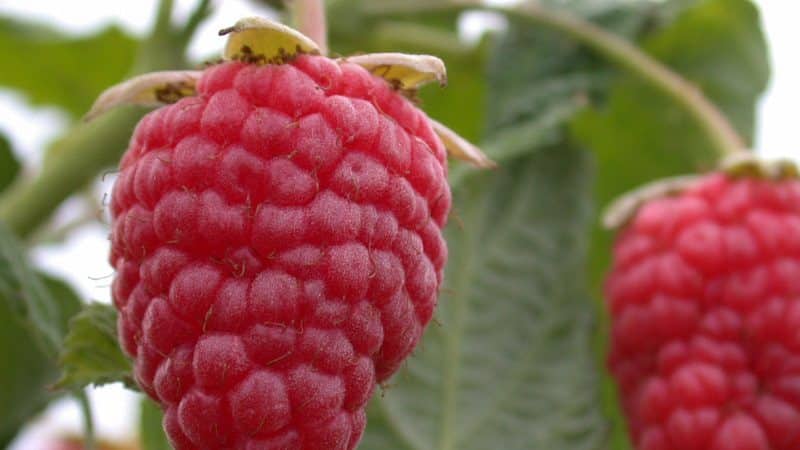
Apricot
Apricot raspberry bushes are medium spreading with straight brown shoots. The thorniness is slight, the leaves are green and wrinkled. The berries are an attractive golden-apricot color, blunt-conical in shape, average weight - 3-6 g. The pulp is sweet and sour, the aroma is moderate, the tasting rating of the variety is 4.5 points.
Apricot is valued for its immunity to diseases and pests - the bushes are rarely damaged by wasps, aphids and spider mites.Like most remontant varieties, Apricot is picky about the location of the site and prefers sunny and well-warmed soil. Recommended for planting in the Central region of the country.
Hercules
The popular variety of remontant raspberry Hercules is unpretentious in careEven a novice gardener can grow a good harvest. Bushes of medium height with straight shoots, hard thorns, growing downwards. The leaves are large and slightly wrinkled, with slight pubescence. The berries are red-raspberry, attractive, weigh about 6.8 g. The pulp is tender, the taste is sweet and sour, aromatic. Variety rating - 4 points.
Among the advantages of Hercules are transportability and keeping quality - if the storage rules are followed, the fruits remain fresh for 10-15 days. Raspberries are grown for personal use and sale; jams, compotes and jams are prepared from the fruits. The variety is susceptible to insects and diseases.
Attention! Remontant raspberries are prepared for wintering: the shoots are bent to the soil, fixed in this position and tied to the bottom wire of the trellis. All foliage is removed from the stems and the bare bush is covered with snow. If ice forms over the bush in winter, pierce it with a shovel. Otherwise, the bush will not receive fresh air.
The most productive
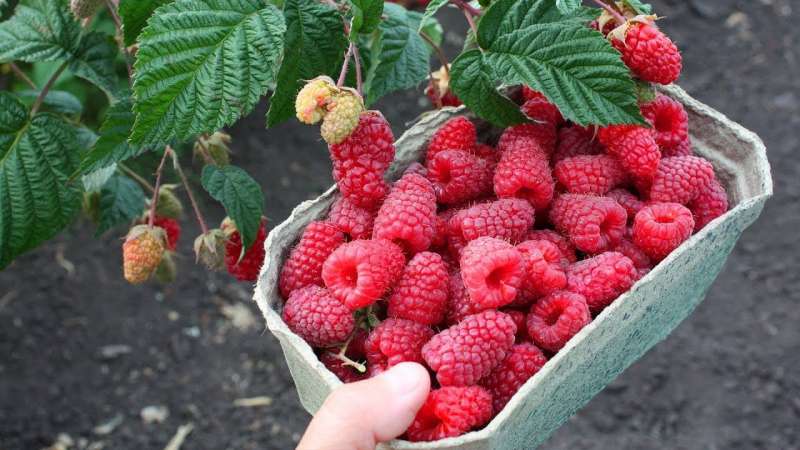
Yield varieties They give summer residents 3 to 6 kg of raspberries per summer. Raspberries are boiled with sugar or frozen, dried and eaten fresh. Yield varieties are grown for personal use and on an industrial scale.
Polka
Semi-spreading bushes grow up to 1.7 m. The shoots are strong, do not bend under the weight of berries, the thorns are small and non-thorny. The berry is round in shape, weighs about 5 g, and has a rich red color. The flesh of Polka is fleshy and tender, the taste is harmonious, sweet and sour.After ripening, raspberries do not crumble or deform and are suitable for transportation and storage. The yield of the variety is from 4 to 5 kg of berries per summer. Fruiting is extended.
Polka is resistant to gray rot and spider mites; leaves and shoots do not dry out or curl. Cover the shrub for the winter, otherwise the buds will freeze. The thorn-free thorns prevent gardeners from scratching their hands while harvesting.
Bryansk miracle
Ripening period remontant raspberries mid-late. The bush is tall and powerful; spacious, light areas are chosen for planting, and the plant is tied to a support. The thorniness is medium, green spines are located along the entire length of the shoots. The berries are conical, light red, weight - from 4 to 6 g. The pulp is aromatic and tender, sweet and sour. The berries are dense and can withstand transportation.
Heat and drought resistance are average, immunity to diseases is high. The yield of Bryansk diva is up to 5 kg per plant per season. Thanks to the vitamin composition of raspberries, jams and preserves are prepared, which strengthen the immune system and protect against colds.
Standard
Standard raspberry does not require support or garter; in appearance, the shrub resembles a raspberry tree. The bushes reach a height of 2 m; in addition to the trunk, there are 6-7 tops. Standard varieties are planted at a distance of 2 m so that they do not block each other’s light.
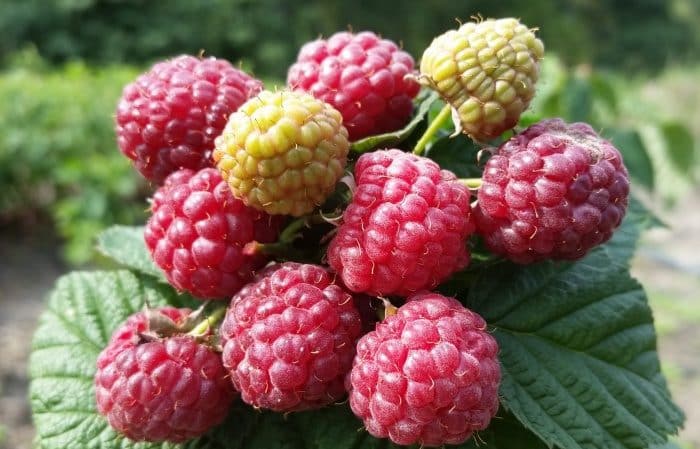
Tarusa
Tarusa raspberries are unique in that they do not form shoots. The height of the bush is about 1.5 m, it has an attractive appearance, performs decorative functions, and decorates the site. Tarusa's berries are large, blunt-conical, weighing about 5 g. The color is bright red with a pinkish tint, shiny. Small drupes are tightly attached to each other. The taste is sweet and harmonious, with a pleasant raspberry aroma.The yield is 3-4 kg of berries per season.
Tarusa is also valued for its ease of care - the plant does not require garter or support, and is drought-resistant. To strengthen the immune system, it is recommended to carry out preventive measures to protect against diseases: remove weeds and shoots, spray with a solution of the drug “HOM”.
Fairy tale
The height of standard bushes is no more than 1.7 m. The shoots are erect and powerful, without thorns. The berries are large, weigh 6-8 g, some reach 10-12 g. The color is red-pink, shiny. When ripe, raspberries do not crumble or crumble, the drupes are strong. The taste is pleasant, sweet with a slight sourness. The pulp is juicy and aromatic, and is universal in use. The productivity of Skazka is 3-4 kg per bush.
The variety is frost-resistant down to -23°C, so it is suitable for planting in central Russia and the Moscow region. Transportability and keeping quality are high; the growing procedure does not require special skills from gardeners.
The sweetest
Choosing the sweetest raspberry is not easy - each variety has a special taste and aroma. Raspberries are valued and actively used not only in cooking, but also in folk medicine and cosmetology.
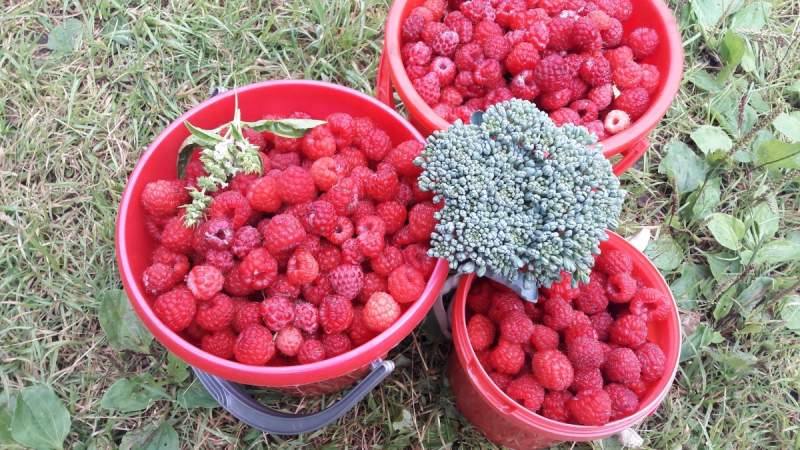
Lovely
The mid-season variety Prelest is universal in use. Bushes of medium height, brownish-brown shoots, fast growing. Green leaves are corrugated. The berries are conical in shape, weigh about 3 g per one, and are raspberry-red in color. The taste is sweet with a slight sourness, pleasant, tasting score - 4.6 points. The berries are canned for the winter and eaten fresh.
The beauty is winter-hardy and does not require shelter for the winter. The thorniness is weak, the immunity to spider mites and rust is high. Prelest raspberries are planted not only in the middle zone and the Central region, but also in the north of the country.
Orange miracle
The Orange Miracle variety is mid-season. Tall plants require support and garter. The shoots are powerful, little shoots are formed. The leaves are green and wrinkled. The berries are large, weight - from 5 to 10 g, obtuse-conical, elongated shape. The color is bright orange, shiny, there is slight pubescence on the surface of the berries. The taste is sweet and balanced. The pulp is tender and aromatic. Resistance to drought and heat is average.
Attention! Sweet raspberries are used to make delicious syrups and confitures. They are served with pancakes and pancakes, making a homemade, flavorful dessert. Some summer residents freeze raspberries - place them in a tight sealed bag and put them in the freezer.
Early
Early raspberries do not differ in taste and commercial qualities from mid-season and late varieties. The first harvest is harvested at the end of June, the fruits grow large and juicy. Raspberries are used to prepare fruit salads, desserts, and summer refreshing drinks. Raspberries are also recommended for children's, dietary and diabetic nutrition.
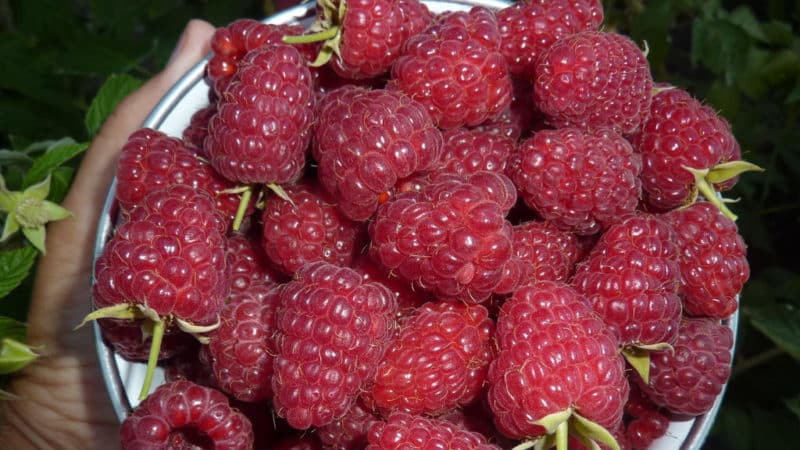
Penguin
The early-ripening remontant variety Penguin is popular in all regions. It is versatile and easy to grow. The bushes are standard, the trunk is low and powerful, the shoots are compact. Penguin is ideal for planting in a small area. Shoots with a strong waxy coating, strong thorniness. The berries are wide-conical in shape, weighing from 4 to 6 g, dark crimson in color, weak pubescence. The drupes are pressed tightly against each other and do not crumble.
The pulp is without aroma, the consistency is dense and elastic, the taste is classic raspberry, sweet and sour. Tasting score: 3.7 points. The heat resistance of the variety is average. With regular spraying of Bordeaux mixture, Penguin is slightly affected by fungal diseases.
Unattainable
Fruiting begins after July 20. The bushes are low, height is about 110 cm. The leaves are large, green, with drooping tips. The shoots are well developed and grow in different directions. Inaccessible can withstand frosts down to -24°C. Adult plants, with proper care, produce a harvest of up to 6 kg. The color of the berries is dark scarlet, weight - from 4 to 6 g, the taste is sweet and juicy, the aroma is average. The drupes are loosely attached to each other, so Inaccessible is used fresh; it is not suitable for transportation and storage.
Average
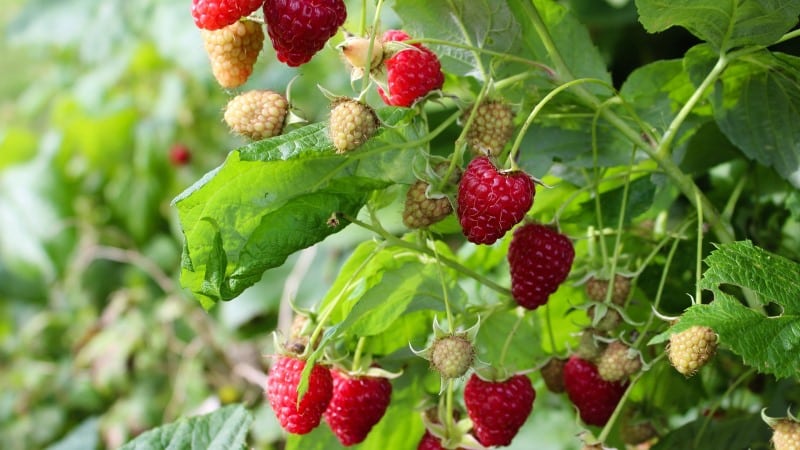
The ripening period for mid-season varieties is early or mid-August. During the growing process, plants require watering and fertilizing. Raspberries love wood ash, nitrophoska and potassium salt. Mineral components support the plant’s immunity and protect against diseases.
Ruby necklace
The bushes are medium spreading, the thorns at the base of the shoots are long. The leaves are green, slightly wrinkled and slightly curled. The flowers are medium, the weight of the berries is about 5 g, the color is bright ruby, original. The pulp is sweet and sour and tender. The Ruby Necklace variety is heat-resistant, rarely damaged by spider mites and wasps, and does not suffer from rot. To increase productivity, it is recommended to plant other varieties next to the shrubs. Over the course of a year, summer residents harvest 2-3 kg of raspberries. The fruits are frozen, dried or processed into jam or compotes. Ruby Necklace bears fruit until September.
Eurasia
The bushes are standard, medium-sized. The shoots are strong with large thorns. The leaves are green and wrinkled. The weight of the berry is from 3 to 5 g, the shape is conical, the color is raspberry-red, and darkens at the moment of ripeness. The pulp is sweet and sour, without aroma, the consistency is delicate. Tasting score of Eurasia - 3.9 points. The variety is resistant to drought and requires shelter in winter.Productivity: 2-3 kg of raspberries per bush. Resistance to diseases and pests is at the level of standard varieties, frost resistance is high. The purpose of the fruit is universal.
Attention! For growth and development, remontant raspberries need nitrogen-containing fertilizers. For one bush use 5 liters of mullein infusion. Fertilizer is applied at the beginning of summer and 2-3 weeks after. Before the procedure, it is recommended to water the bush with warm water.
Late
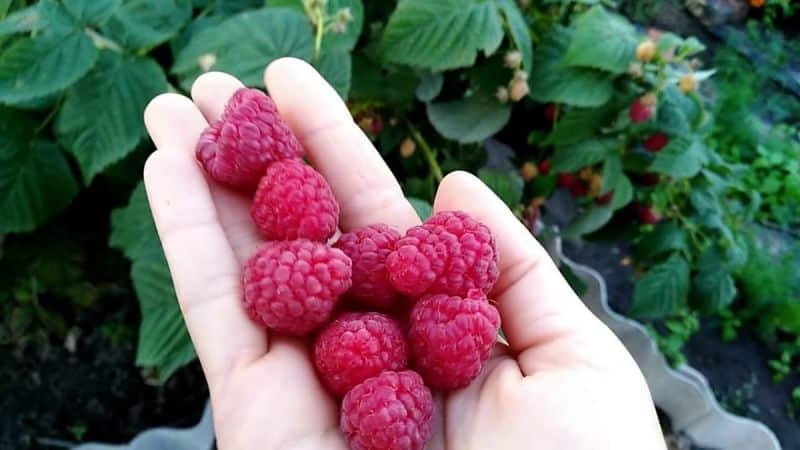
Late varieties of remontant raspberries ripen in August and bear fruit until October. The harvest is used for storage and transportation; raspberries do not crack or crumble into drupes.
Indian summer
The Indian summer harvest is harvested in the second ten days of August. The fruits grow large and juicy, weighing about 3 g. The shape is truncated-conical, the color is red-pink. Raspberries are distributed along the entire length of the shoots. The taste is sweet, tasting score - 4.5 points. The bushes are small, about 1.5 m high. The branches grow in all directions. The disadvantages of this variety include large and thorny shoots, so it is recommended to harvest with gloves. The yield of Indian Summer is 1-2 kg of berries per bush.
Golden domes
The variety is high-yielding, universal in use, and easy to care for. The bushes are low, medium spreading. The shoots are light green, slightly pubescent, and erect. Leaves are wrinkled and curled. The berries are yellow, hemispherical in shape, average weight - 3.8 g. During ripeness, the fruits acquire a golden-apricot hue. The pulp is sweet and sour, balanced, tender in consistency. The aroma is average.
Winter hardiness of Golden Domes is down to -25°C, drought resistance is also high. Raspberries are rarely affected by aphids and mites, rust and powdery mildew.The advantages include self-fertility, which guarantees stable yields.
Conclusion
In Moscow and the Moscow region, farmers recommend planting remontant raspberry varieties Penguin, Orange miracle, Fairy tale, Bryansk miracle, Unattainable. Unlike conventional varieties, they produce crops several times per season. The berries grow large and juicy, suitable for consumption from the bush, transportation and transportation. In terms of care, remontant raspberries are not much different from growing ordinary ones; The main thing is to pay attention to mineral and organic fertilizers. When choosing, pay attention to the size and taste of the fruit, features of agricultural technology, and yield. Reviews from gardeners with photos of the harvest and ratings of the best will also help you choose the right variety.